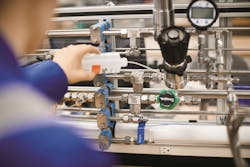6 tips for maintaining industrial fluid system safety
Across a range of global process-driven industries, industrial fluid systems carry the responsibility of transporting high-pressure, high-temperature liquids and gases throughout different plants and complexes. The safety of workers who regularly interact with these systems and the quality of end products produced in them often depend on optimizing their performance. That means choosing the right components and working with the right suppliers.
Think of hydrocarbon processing plants, for example. These complex operations depend on the safe, reliable operation of a variety of fluid systems, which themselves can present numerous potential leak points and other risks.
In these critical environments, failure is not an option. So, how do you ensure all parts of the fluid system are operating as intended to optimize worker safety and product quality? Here is a handy list of tips for enhancing the most critical parts of any industrial fluid system.
1. Seek simplicity in system designs
Processes in an industrial facility might be complex — but fluid system design does not have to be.
Simpler designs, with fewer components, bends and fittings, present fewer opportunities for leaks, which can be dangerous and costly, and may contribute to fugitive emission pollution.
Consider a fluid system run containing multiple direction changes. A traditional nonwelded pipe assembly will require numerous elbows and connection points compared to a bendable tubing run, which may only have four fitting connection points (see Figure 1 for a side-by-side comparison). Modern piping systems are more commonly welded today and can include swept bends, eliminating several leak points. However, maintaining these systems introduces the complexity of on-site welding operations to complete repairs.
You can also consider working with a tube and fitting supplier that offers prefabricated system assemblies. This is a helpful way to simplify design requirements in your operations while also offloading some labor needs so you can focus on other priorities. If you are considering this option, make sure your supplier has considerable design expertise and knowledge of applications like yours.
2. Select applicable components
Correct material selection to combat corrosion is highly important in a fluid system that is designed with longevity in mind. Additionally, selecting ancillary products like tubing supports can play a role in ensuring fluid systems are best protected from the different types of corrosion that can compromise system performance. Engineered combinations, which use different materials for fittings compared to tubing, should be considered to minimize the cost impact of selecting alternatives to stainless steel.
3. Do not intermix products from different suppliers
Intermixing tubes and fittings from different manufacturers can cause issues, many related to the hardness and softness issues described above. See Figure 2 for an example. Plus, even if a component is made of the same material, different manufacturers may not make the component to the same tolerance specifications, which can lead to incompatibility and unpredictable performance.
Obtaining the kind of leak-tight seal that can withstand high pressure, vibration, vacuum and temperature changes is critical. Selecting tubing and fittings from the same manufacturer can make a significant difference in reliability and performance.
4. Always follow the manufacturer’s instructions
Once you have selected a manufacturer for your tube and fitting needs, it is important to follow its specific instructions for proper assembly, disassembly and installation. This may be straightforward, common sense advice, but it is always worth a reminder. Even the most experienced fluid system technicians should give a close read to these directions, which can help avoid common installation errors such as:
- Undertightening fittings: This can occur when technicians tighten fittings by “feel,” which creates opportunities for leaks and blowouts.
- Not resting tubes firmly on the tube fitting’s shoulder: Technicians should always check for this issue during installation.
- Failing to properly check tubes for ovality, defects or scratches: Each of these deformations can potentially compromise a seal.
- Not checking extremes of wall thickness against fitting manufacturers’ suggested limitations: Components and tubing not rated to meet a system’s operating pressures are likely to fail.
- Failing to use a proper gap inspection gauge: Using one helps to ensure sufficient fitting pull-up, as shown in Figure 3.
5. Consider your operating conditions during the design stage
It can be easy to discount regular operating conditions during design and assembly, since these practices occur while the fluid system is deenergized. But vibration, pressure levels and temperature changes all occur during regular operation. Therefore, you should ensure your system has been designed with these factors considered.
Here are a few quick tips:
- Use proper supports to ensure tubes and fittings will not become overfatigued under high-pressure operation.
- Allow for a proper range of motion for moving components, as motion can strain components and connection points.
- Use a hose instead of tubing if significant vibration will occur during normal operation.
6. Find a fluid system component supplier that supports your needs
There are numerous component suppliers for industrial fluid systems. But operators that are seeking to optimize their operations should take the time to evaluate not just the quality of the products, but the service and support those suppliers can provide too.
Working with a knowledgeable, collaborative supplier for your critical fluid system needs — one that can help train your teams on these and other best practices — can make a big difference.
Mike Frost is regional area manager, field engineering (Asia-Pacific) for Swagelok Company.
[Editor’s note: An original version of this article appeared on the Swagelok Reference Point blog found here: www.swagelok.com/en/blog/industrial-fluid-system-safety-checklist.]
